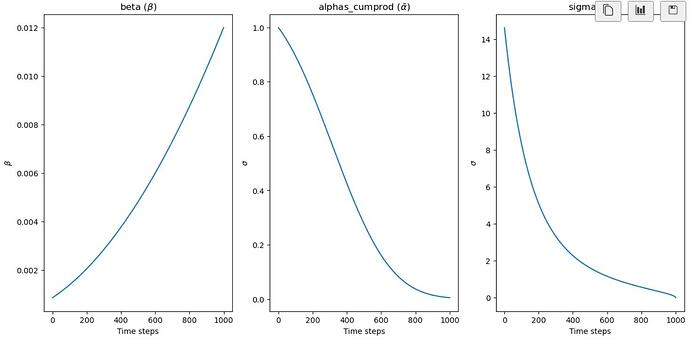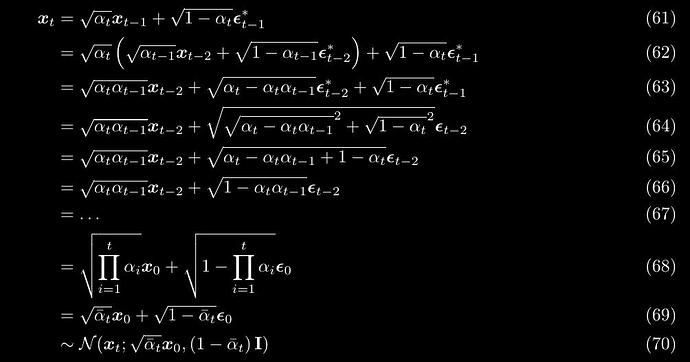According to my understanding so far, which could be wrong, the scheduler is trying to create different levels of variance for each of the 1000 time-steps.
For example, if you have an input x_{t-1} , for example a latent, putting it through the Unet for one iteration in the for-loop (1000 steps) will produce an output x_{t} that has a mean of \sqrt{1-\beta_{t}} \times x_{t-1} and a variance of \beta_{t} i.e standard deviation = \sqrt{\beta_{t}}, something like
x_{t} = \sqrt{1-\beta_{t}} x_{t-1} + \sqrt{\beta_{t}}\epsilon
You could then do a trick to express x_{t} in terms of x_{0} (the original image from the dataset) instead of x_{t-1}, by creating a new variable called alpha using \alpha = 1 - \beta. After some maths (see “Tedious Math” at the end of this post for details), you will get a cumulative-product version of \alpha with a hat on top \bar{\alpha}:
x_{t} = \sqrt{\bar{\alpha_{t}}} x_{{0}} + \sqrt{1- \bar{\alpha_{t}}}\epsilon
Moving x_{{0}} to the left-hand-side, we get
x_{0} = \frac{x_{{t}}}{\sqrt{\bar{\alpha_{t}}}} - \sqrt{\frac{1- \bar{\alpha_{t}}}{\bar{\alpha_{t}}}}\epsilon
\sqrt{\frac{1- \bar{\alpha_{t}}}{\bar{\alpha_{t}}}} is the sigmas that @KevinB highlighted in his post, Point 4), where he wrote
*\Sigma = \sqrt{\frac{1 - \alpha\_cumprod}{\alpha\_cumprod}}
and is expresed in code as
sigmas = np.array(((1 - alphas_cumprod) / alphas_cumprod) ** 0.5)
Note that alphas_cumprod (\bar{\alpha}) is a cumulative product \prod_{i=0}^t \alpha_{i} , and as pointed out by @KevinB, involves the multiplication of many terms
np.cumprod([1, 2, 3, 4])
> array([1, 2, 6, 24])
So now, if you run the following code, you can get alphas_cumprod or \bar{\alpha}
beta_start = 0.00085
beta_end = 0.012
betas = torch.linspace(beta_start**0.5, beta_end**0.5, 1000, dtype=torch.float32) ** 2
alphas = 1.0 - betas
alphas_cumprod = torch.cumprod(alphas, dim=0)
and if you run the following code you get sigmas or \sigma = \sqrt{\frac{1- \bar{\alpha_{t}}}{\bar{\alpha_{t}}}}
sigmas = np.array(((1 - alphas_cumprod) / alphas_cumprod) ** 0.5)
sigmas = np.concatenate([sigmas[::-1], [0.0]]).astype(np.float32)
sigmas = torch.from_numpy(sigmas)
print("Sigma max:", sigmas.max())
> Sigma max: tensor(14.6146)
Plot \beta, \sigma and \bar{\alpha} using the following code
fig, axs = plt.subplots(1,3,figsize=(15, 7))
time_step = torch.linspace(0,1000,1000,dtype=torch.int)
axs[0].plot(time_step, betas)
axs[0].set(xlabel = "Time steps", ylabel ="$\\beta$")
axs[0].set_title("beta ($\\beta$)")
time_step = torch.linspace(0,1000,1000,dtype=torch.int)
axs[1].plot(time_step, alphas_cumprod)
axs[1].set(xlabel = "Time steps", ylabel ="$\\sigma$")
axs[1].set_title("alphas_cumprod ($\\bar{\\alpha}$)")
time_step = torch.linspace(0,1001,1001,dtype=torch.int)
time_step = torch.linspace(0,1001,1001,dtype=torch.int)
axs[2].plot(time_step, sigmas)
axs[2].set(xlabel = "Time steps", ylabel ="$\\sigma$")
axs[2].set_title("sigma ($\\sigma$)")
Note that for \beta, instead of a straight-line schedule using
beta = torch.linspace(beta_start, beta_end, noise_steps)
a slighly curved schedule is used for stability diffusion instead
beta = torch.linspace(beta_start**0.5, beta_end**0.5, 1000) ** 2
Tedious Math
The tedious maths to get alpha_cumprod (\bar{\alpha}) is provided below
Source: Understanding Diffusion Models: A Unified Perspective













